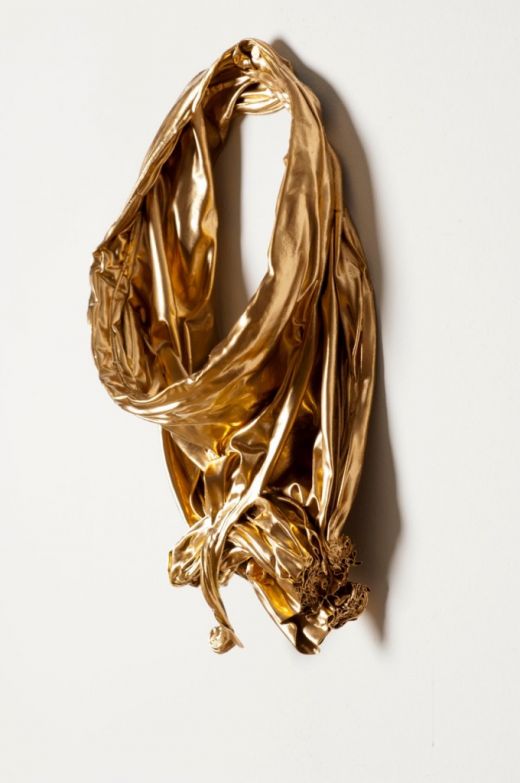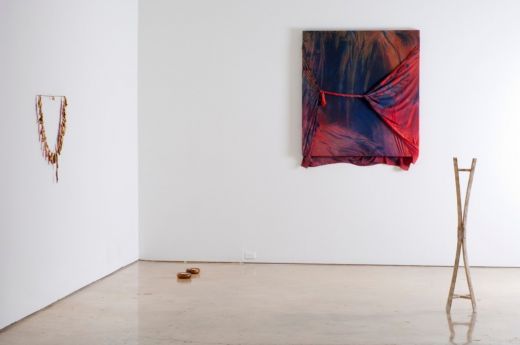Catherine Czacki/April Street
Fareena Qadir

April Street, I'll keep you close like fingers around a fragile neck (collar), 2013. Gold leaf, acrylic on hosiery. 12 x 8."
October 16 – November 16, 2013
In this intimate exhibition of California-based Catherine Czacki and April Street, sculptures and wall-hangings are connected by their common link to the human body, albeit not in a literal sense. In each, the body is an inferred presence and deferred absence. The artists highlight how things are never simply objects, which leads the viewers/lives to begin an analysis of the place of objects in their own life.
Using objects both found and given, Catherine Czacki’s work prompts the viewer to decipher the narratives that led to their creation and display. Her objects are personal and therefore have meaning that is obscure to us. They appear to have some utility and need an individual to engage them, thus implying an invisible body. Furthermore, each object is accompanied by a piece of writing by Czacki. By playing with text and object, she further changes the meaning of the objects. An example of this is the artist’s display of a suicide brake, otherwise known as a motorcycle clutch, given by her friend Adrienne Garbini. This device is mounted on a wood and papier-mâché base and then renamed “Suicide Break” (2013). Another paired piece is “Symbolom I, II” (2013). Two wooden bowls with paper pulp are for sale, yet one of them remains without a price tag. The artist placed a ring into a bowl of paper pulp. If anyone wishes to buy this particular piece, they need to contact her so that she can personally tell them that the ring belongs to her mother. The artist’s insistence on disclosing this personal information gives way to a shared conversation between artist, viewer and potential buyer, showing the possibility of communion and sentimentality.

(Right Center) April Street, A fairy tale for the leisure class (hand holding), 2013. Acrylic, hosiery on wood, 59 x 50 inches.
April Street’s artwork is closely linked to the body. The sensual and fleshly smears of paint on the hosiery that drape the canvases or hangs twisted as a rope result from performance in which the artist wraps herself in the sheer fabric and holds her body against a freshly painted canvas in a sleeping position. These deeply personal actions reveal the vulnerability of the artist and create a private exchange between her and the object. She then unwraps the hosiery from her body and drapes it over the canvas so that, like the performance, the canvas remains private. “Wandering limb #11” (2013) offers an impression of a wingspan of the artist. “Loose Rope” (2013) also uses hosiery, but this time it has been twisted and turned into a stunning 13-foot rope that runs from the floor to ceiling, with the end cast in hard bronze. The prints left by the movements of the artist on the hosiery appear deliberate and slow. They are nearly photographic and the viewer can feel the artist’s proximity to the work even in her absence. The absence of both artists is cast into relieve in the public space of the gallery.
Both artists share pieces that have been close to their body, physically or emotionally. It is this openness to scrutiny that involves the viewers. Whether the artists truly reveal themselves, however, is debatable. One is left trying to analyze how Catherine’s sculptures may be personal to her, whilst April offers only a hint at her naked body through the remnants of paint left by her private performance.










